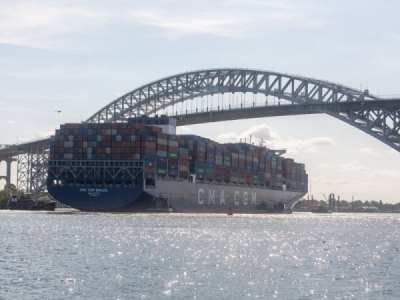
Posted on September 30, 2020
New Jersey and New York ports love big boats and they cannot lie.
And by the increased number of ultra-large container ships that came to the port last year, supersized ships might love bringing goods to the port.
In 2016, only 34 ultra-large container ships came to the Port. That number jumped to 271 of the mammoth ships last year, the Port Authority of New York and New Jersey officials said.
The largest ship to call on the port, the 1,200-foot-long CMA CGM Brazil sailed under the Bayonne Bridge on Sept. 12, making it the biggest container ship to visit any eastern U.S. port.
The capacity to handle such gigantic vessels is increasingly important to the port’s competitive future, Port Authority Executive Director Rick Cotton said during a Thursday board meeting. The first mammoth container ship sailed under the raised Bayonne Bridge deck in September 2017.
“The future is highly dependent on the shipping industries shift to big ship operations,” he said.
The agency prepared for that future by spending $5.3 billion in port improvements, that included a $1.7 billion raising of the Bayonne Bridge roadway, a $2.1 billion deepening of harbor channels, and a $600 million ship-to-rail container transport system.
“They were necessary to accommodate and attract ultra-large container vessels such as the Brazil,” Cotton said. “So the percentage of vessels calling on our ports in the ultra-large vessel category increased from 1.4% (in 2016) to 12.3%.”
It also gave the Port Authority bragging rights, taking the title for second busiest port in the nation away from the Port of Long Beach, California last year.
“It (arrival of the Brazil) symbolized the payoff of the Port Authority’s investment and underscores the ports 2019 achievement of being the second busiest port in the nations, surpassing Long Beach for the first time in over two decades,” Cotton said.
The Brazil can carry 7,536 of the standard 40-foot shipping containers that can be seen mounted one at a time on truck chassis typically seen on the nation’s highways.
But except for the containers being trucked to distribution centers and warehouses off the New Jersey Turnpike in Central Jersey, the authorities ship-to-rail container facility will put those with inland U.S. destinations on trains, Cotton said.
“The efficiency which goods can be moved from our terminal on to rail transport to the marketplaces in the interior of the country is playing a major role to increase the ports container volume,” Cotton said.
The ports provided the one bright spot in an otherwise dismal revenue report for August and September.
While traditional revenue earners such as the airports and to a lesser extension, the authority’s bridges and tunnels were down because of traffic declines due to the coronavirus, the ports have bounced back to 2019 levels, Cotton said.
Thank you for relying on us to provide the journalism you can trust. Please consider supporting NJ.com with a subscription.
Larry Higgs may be reached at lhiggs@njadvancemedia.com.
Source: nj.com





